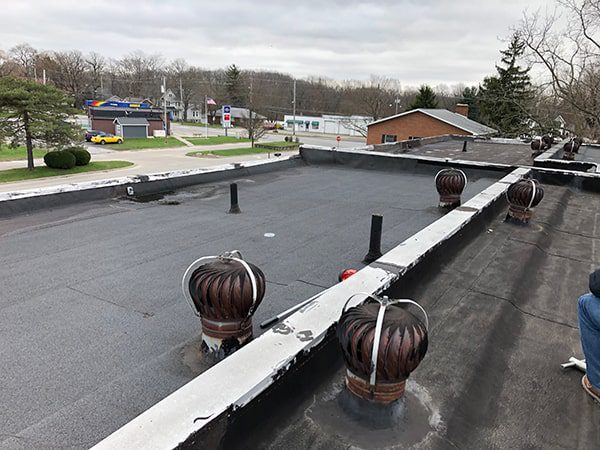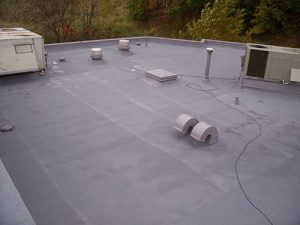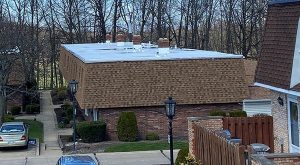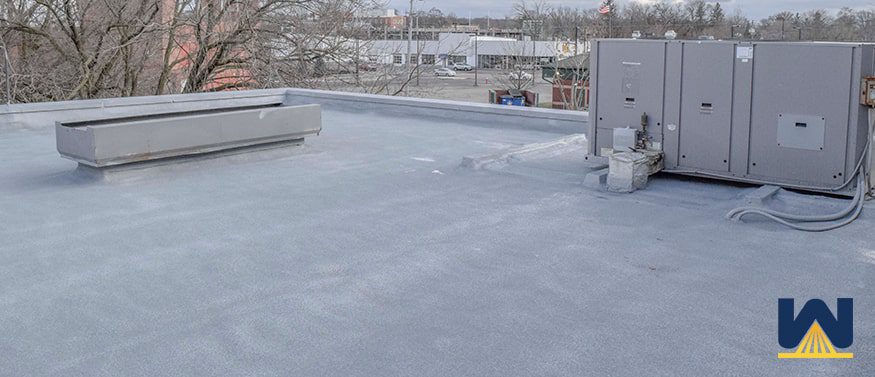So, you’re the owner of an apartment complex and you’re having some roofing problems.
Renters in building 2 say there are brown spots forming on the ceiling.
Renters in building 7 say parts of the roof have been blown off and are lying in the front yard.
You’ve got some roofing issues and you need them solved.
Should you go with a TPO roof again? EPDM? Spray foam? Metal?
Today, we wanted to give you the pros and cons of spray foam roofing, and specifically how they perform on apartment complexes.
Now I know you’ve probably never heard of spray foam roofing, but please read on. Open your mind to a new option and it may be beneficial. The best way to make the smartest decision for your roof is to know all the possible options you have.
Since West Roofing Systems has been installing spray foam roofs since 1979, we’ve seen some benefits (and some problems) specific to installing them over apartment complexes.
Let’s get started!
What is spray foam roofing?
Spray polyurethane foam is a material that’s sprayed as a liquid so it can expand into a foam, creating a solid layer across an existing roof.
Here’s a quick video of an installation:
Spray foam is usually applied 1-2 inches thick and is protected from damaging UV rays by installing 2 thin layers (20-30 mils total) of silicone coating over top of the foam.
For added strength, granules are embedded into the topcoat of coating.
Spray foam roofing has many advantages, but for apartment complexes, the ones that stick out are:
- A spray foam roof can fully encapsulate firewalls, which is an area where single-ply roofing systems are more prone to failure because they aren’t monolithic.
- A spray foam roof can cost-effectively eliminate the issue most apartment complexes have, which is ponding/standing water.
Pros of spray foam roofing on an apartment complex
A spray foam roof can fully encapsulate the firewalls of an apartment complex
Most apartment complexes have flat roofs. And on those flat roofs are large “ribs,” which are firewalls. Firewalls prevent fires from spreading from apartment to apartment, damaging the entire building.
If apartment #1 catches fire, the firewall prevents apartment #2 from also catching fire.
Here’s a photo of a firewall on top of an apartment complex:

You can see the firewall as the raised, white section on the roof.
Since most apartment complex roofs are single-ply, either EPDM or TPO, there’s considerable flashing details needed to seal those firewalls so no water has an opportunity to enter.
Since spray foam is monolithic, meaning the entire roof becomes one layer, you can spray right on top of the firewalls, bringing penetrations and the field of the roof together.
Here’s a photo of multiple penetrations coming together as one roofing unit:

With spray foam, all the transitions and changes can be fully encapsulated with foam, eliminating any flashing detail work.
When flashings are installed incorrectly (or the flashing detail degrades over time), this creates an opportunity for water to enter your roof system.
Spray foam eliminates ponding water on an apartment complex roof
Have you ever seen the roof on top of an apartment complex? If not, here’s what they usually look like:

See anything “not-so-right” about this roof?
The answer is that there’s water still on the roof, just “sitting” there, what’s ironically called “standing water.”
Standing water, sitting water, ponding water…they all mean the same thing. It’s water that should be off the roof, but for some faulty technical reason, the water is still on the roof.
Standing water will reduce the lifetime of any roofing system. That’s why draining systems were invented.
But on apartment complexes, these roofs normally “sag” over time, which negatively affects the slope of the initial installation. Water no longer goes where it was supposed to go.
To fix this, a tapered roof system would need to be designed and installed. A tapered roof system is where the slope or “pitch” of the roof is formed by the insulation itself, to allow water to drain off.
Tapered roof systems can be very expensive; between $10 and $14 per sq. ft.
A complete spray foam roof installation is $5 – $10 per sq. ft., comfortably in the ballpark of other roofing systems.
Spray foam eliminates standing water because a contractor can customize the thickness of the installed foam.
A spray foam contractor can recognize where the low areas are and raise them up, so the entire roofing system is designed for the water to run toward the drains.
Spray foam roofs are solid and fully adhered to the roofing layer underneath, so they will not sag or change slopes at any time.
Cons of spray foam roofing on an apartment complex
Potential for overspray on balconies
One problem that spray foam roofing has versus other roofing systems is that they are spray-applied, meaning they can be sprayed over the edge and onto balconies when there are high winds.
Spray foam roofing contractors use wind screens to eliminate “overspray,”but sometimes it happens.
Most apartment complexes will notify the renters that the roof is being done and that the balconies should be clear, but sometimes this doesn’t happen (or the renters ignore the request), and the renters may have a very small amount of foam on their assets.
This can be easily removed by scraping the foam off with a razor blade, using some elbow grease with a clay bar, or by letting foam disintegrate on its own with the exposure to sunlight.
NOTE: the spray foam on your roof will not disintegrate because it will be protected with an elastomeric coating.
Either way, any spray foam roofing contractor will work with the renters on removing any overspray, even though it’s quite rare to have any in the first place.
High traffic areas can be a problem
Cars in the parking lot are no issue, as any spray foam roofing contractor can cover cars when it’s time to spray foam.
One issue that needs to be monitored is the public coming in and out of the apartment complex.
Spray foam contractors use windscreens or spray out of a booth to disable any material going off the roof, but with apartment complexes, traffic can be high.
To prevent any overspray, the contractor will lay out “do not enter” signs marked with cones and tape, denying access for a short period of time, usually under 1 hour.
This isn’t the biggest issue, but it’s a problem that still exists.
Spray foam roofs can be applied over existing roofs
Hopefully, you learned the pros and cons of installing a spray foam roof on an apartment complex.
The best part though, is that if your insulation isn’t saturated, and this is your only roofing layer, there’s no need to remove the existing EPDM or TPO.
Spray foam can be installed right on top, which can save money compared to a single-ply installation, in which you’ll need to remove the entire roof, transport the materials to landfills (bad for the environment), and then pay for a tapered EPDM or TPO system.
If you have any other questions regarding spray foam roofing, please take a glance at our Ultimate Guide to Spray Foam Roofing. There’s no information needed to view the entire document, which answers common questions about spray foam roofing, such as:
- How does a spray foam roof perform in colder weather?
- How does the warranty work on a spray foam roof?
- Can a spray foam roof withstand bird pecking?
- And much more!


